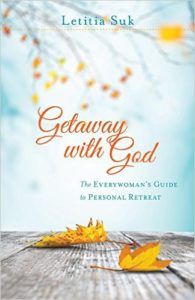Does spending time with God sound like just one more thing to check off an ever-increasing to-do list? How are you supposed to fit in anything that threatens to be more time-consuming? Too often there’s simply no room to experience the intimacy, grace, and peace that God offers us.
 In Getaway with God, Letitia Suk does more than invite readers to step away from life’s pressures to take a personal retreat. It shows you exactly why you must — for your sake and for your family’s.
In Getaway with God, Letitia Suk does more than invite readers to step away from life’s pressures to take a personal retreat. It shows you exactly why you must — for your sake and for your family’s.
With grace and warmth, Suk provides step-by-step guidance and the necessary tools to enable any woman on any budget to plan time away, whether it’s a quick, half-day break or a weeklong time of restoration.
Q: Why does everyone need to take the time to go on a retreat alone?
Perhaps not everyone does, but any woman who is in need of deeper rest, longing for a connection with God for more than a minute or feels overwhelmed by the to-do’s of her life would highly benefit. I guess that would describe all of us at some time or another!
Time after time, year after year, I came away filled with a renewed sense of purpose, clarity of vision, trust in God’s ability to untie all the knots of my life and overwhelming sense of being loved. There’s nothing quite like a retreat to provide that much restoration in such a relatively short amount of time. Many of us are familiar with the relationship boost a getaway with your spouse or family can provide, and a getaway with God has the same results for our souls.
Q: Tell us a little bit about your new book. Is Getaway with God a precise, step-by-step guide for personal retreats?
Yes, in a very warm, conversational tone, the first part is a detailed guide for all the how-to’s/what if’s of a shorter retreat. It is designed to bring along as a guidebook to be referred to throughout the retreat.
I include:
- Detailed schedules
- Recommended reading
- Packing lists
- Retreat exercises
- Guidance for doing small group personal retreats
- Links to discover retreat centers
- Creative ways to change up your prayer life
The second half invites the reader to take a longer life-review retreat, and I use my own five-day retreat as a model. In this section the reader is guided to take a deeper look at where she has been, where she currently is and where she is going.
Q: When people hear the word “retreat,” they often think of mountain cabins, church groups and long drives to get there. Is it possible to take a personal retreat without going far or spending a lot of money?
Definitely! If you are on a tight budget, a convent or retreat facility usually fits the bill for anonymity and few distractions. Retreat centers are sprinkled throughout the country in places you wouldn’t expect them. In the appendix section of the book are links on how to find them. Check the website or call ahead to see if they serve meals and if special requests can be accommodated. Do they have a fridge available for you to bring your own meals? Is there a place to walk? Is silence the norm?
For a no-cost retreat, consider asking a friend who is gone during the day if you can use her place, or trade homes with a friend for a weekend. When my children were starting morning programs in school, I asked a neighbor from church if I could use her apartment for a morning retreat while she was downtown at work. I didn’t have the luxury of an overnight or even a full day, but the change of venue and close proximity created just the place I needed.
An outside retreat at a public garden, large park or on the beach can work in the right kind of weather for a shorter retreat. Bring along something comfortable to sit on and create your own sacred space.
One word of caution: Staying home to retreat may seem like an ideal solution. But if possible, get out of your house. Too many distractions, including undone chores, ringing phones and getting chicken out to thaw out for dinner, can derail the best of plans.
Q: What other reasons do women give to not take time away? What advice do you give for eliminating excuses?
This comes up so often there is a whole chapter in the book titled “Common Concerns.” Some of these concerns that can hold women back include fear of the unknown or of being alone. A personal retreat is a new experience for most women. Some women hold off because of the uncertainty of whether or not they will get anything out of it. While we can’t predict exactly what will happen, I can assure you something will change for you as a result of the retreat. Time and money issues are another concern, and I like to remind the reader to consider the expense as an investment in their spiritual life. From both the time and money angles, this investment in getting alone with God will provide dividends to live on the rest of your life.
Finally, lack of family support can be a real issue. It can be difficult to get your husband’s blessing, especially if you’re not quite sure about a retreat yourself. I encourage women to start with a short retreat and think of the refreshed and revived wife and mom their family will receive afterward. Isn’t that a great tradeoff for everyone? Try a getaway in which your absence minimally affects your family. Each common concern is addressed with reassurance and responses.
 Q: In Getaway with God, you offer a “menu” of retreat types. What are some of the options you discuss?
Q: In Getaway with God, you offer a “menu” of retreat types. What are some of the options you discuss?
I invite women to choose a theme to start with but to feel free to jump to something else during the retreat as God leads. Three common themes are:
1) Rest and Restoration: Many times you have to start with a nap or two before you are ready to think about anything. This type of retreat focuses on sleep, nutrition, taking walks and simply preparing to experience the favor of the Lord without doing much else.
2) Listening to God: Sometimes we are seeking God about direction or guidance but never have time to listen. A listening retreat provides that time to pray, read and create space for the still, small voice.
3) Planning: It’s easy to get carried along in the swirl of our to-do’s without stopping to sort out our day-to-day lives, much less our future. This type of retreat might include goal-setting for both the long- and short-term, reviewing our current commitments and adding or removing items from our daily round.
Q: Share with us the rhythm of the Sabbath and how we can observe it, even in today’s fast-paced life?
There are many styles of Sabbath, and the one common component is to stop and rest. So how does a busy, tightly scheduled woman of the 21st century pull this off? By first making the choice to do so and then finding a model that works for each season of her life. Whichever style you choose to practice Sabbath, the point is to slow down with Jesus and find those things that refuel you. The chapter “How Can You Get Away without Going Away” has a lot of suggestions to try.
In this empty-nest season of my life, observing Sabbath starts with choosing to change the pace. After coming home from church on Sunday, I usually do very little. As an introvert, I gravitate toward quietness as a way of getting restored. What does that mean? I schedule very few social events, avoid housework (other than cleaning up after myself), certainly don’t schedule meetings and mostly stay off the phone and the computer for anything that’s work-related.
Instead, I enjoy a longer prayer time and exchange my Monday – Saturday readings for some Sunday-only selections, such as reading all the additional Scriptures suggested in my current devotional. During the afternoon I might read the newspapers from the week (since they are always piled up), take a nap or a walk, read something fun and watch TV in the evening with my husband over a bowl of simple soup.
For you extroverts, practicing Sabbath might include getting together with life-giving friends. For many families, Sabbath is an opportunity to connect. For family members who commonly go their own ways during the week, what a great way to grow closer, relax and enjoy time together! Here are some ideas that might help you plan:
- Play games together at home. Watching a movie can work too, but it is not as interactive.
- Parents can take turns “on duty,” one spending time with the kids while the other enjoys time alone to refill and restore. Single parents can do the same with a friend.
- Read aloud to your family on Sunday nights (or whichever night is your Sabbath). My husband and I read through the whole Little House and Narnia series while we munched on countless bowls of popcorn and sliced apples.
- Store a collection of crafts/activities for Sabbath-only use. Make sure they’re fun.
Q: The Bible promises when we walk in obedience to God, the enemy will try to thwart us. How can we combat the discouragement such attacks can bring?
I wish I could tell women not to worry about this, but going on a retreat does kick up some opposition. Can you imagine how threatening five days with God is to the enemy of our souls? It often shows up close to the retreat when you want to back out, usually as health or family issues. When a lingering fever showed up in my body before my first long retreat, I felt unprepared. I felt like an arsenal was unleashed to try to keep me home.
I wish I could sugarcoat this part of the story, but it may happen to you too. Maybe not a fever, but something will likely show up to deter you and cause you to second-guess the whole thing. Don’t give in to fear. Hang on to truth and remind yourself over and over and over again that God is in control. If He invited you to come on a retreat, He will see that you get there.
 Learn more about Getaway with God and Letitia Suk at www.letitiasuk.com, on Facebook (Letitia.Suk.Author) and via Twitter (@LetitiaSuk).
Learn more about Getaway with God and Letitia Suk at www.letitiasuk.com, on Facebook (Letitia.Suk.Author) and via Twitter (@LetitiaSuk).

